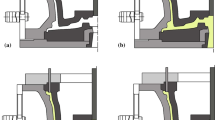Abstract
Experiments were conducted to verify the feasibility of cooling process for one aluminum alloy wheel during low-pressure die casting, and the results showed there were some macroporosity defects in the junctions of small spokes. Numerical simulation was implemented, and the rational cooling and insulation process was determined by analyzing the solidification times of different stages at some locations of casting. The simulation and experimental results both demonstrated the insulation spots had a good effect on prolonging solidification time at the location with thin wall thickness, preventing the feeding paths cutoff prematurely and decreasing the size of porosity defects distinctly.

























Similar content being viewed by others
References
M. Merlin, G. Timelli, F. Bonollo, F. Bonollo, G.L. Garagnani, Impact behavior of A356 alloy for low-pressure die casting automotive wheels. J. Mater. Process. Technol. 209, 1060–1073 (2009)
J.H. Kuo, F.L. Hsu, W.S. Hwang, Development of an interactive simulation system for the determination of the pressure-time relationship during the filling in a low pressure casting process. Sci. Technol. Adv. Mater. 2, 131–145 (2001)
J.A. Hines, Determination of interfacial heat-transfer boundary conditions in an aluminum low-pressure permanent mold test casting. Metall. Mater. Trans. B 35B(4), 299–311 (2004)
B. Zhang, S.L. Cockcroft, D.M. Maijer, J.D. Zhu, A.B. Phillion, Casting defects in low-pressure die-cast aluminum alloy wheels. JOM 57(11), 36–43 (2005)
A.E. Miller, D.M. Maijer, Investigation of erosive–corrosive wear in the low pressure die casting of aluminum A356. Mater. Sci. Eng. A 435–436, 100–111 (2006)
B. Zhang, D.M. Maijer, S.L. Cockcroft, Development of a 3-D thermal model of the low-pressure die-cast (LPDC) process of A356 aluminum alloy wheels. Mater. Sci. Eng., A 464, 295–305 (2007)
X. Zhang, S. Tong, L. Xu, S. Yan, Optimization of low-pressure die casting process with soft computing, in Proceedings of the 2007 IEEE International Conference on Mechatronics and Automation, Harbin, China, pp. 619–623 (2007)
D.M. Maijer, W.S. Owen, R.A. Vetter, An investigation of predictive control for aluminum wheel casting via a virtual process model. J. Mater. Process. Technol. 209, 1965–1979 (2009)
G. Mi, X. Liu, K. Wang, H. Fu, Numerical simulation of low pressure die-casting aluminum wheel. China Foundry 6(1), 48–52 (2009)
P.W. Cleary, Extension of SPH to predict feeding, freezing and defect creation in low pressure die casting. Appl. Math. Model. 34, 3189–3201 (2010)
X.M. Shi, D. Maijer, G.A. Dumont, Determination of optimal location to monitor temperature in low pressure die casting process. Mater. Sci. Technol. 27(6), 1073–1083 (2011)
C. Reilly, J. Duan, L. Yao, D.M. Maijer, S.L. Cockcroft, Process modeling of low-pressure die casting of aluminum alloy automotive wheels. JOM 65(9), 1111–1121 (2013)
G. Nicoletto, G. Anzelotti, R. Konecna, X-ray computed tomography vs. metallography for pore sizing and fatigue of cast Al-alloys. Procedia Eng. 2, 547–554 (2010)
M.A. Islam, Z.N. Farhat, The influence of porosity and hot isostatic pressing treatment on wear characteristics of cast and p/m aluminum alloys. Wear 271, 1594–1601 (2011)
N. Vanderesse, E. Maire, A. Chabod, J.Y. Buffiere, Microtomographic study and finite element analysis of the porosity harmfulness in a cast aluminium alloy. Int. J. Fatigue 33, 1514–1525 (2011)
Y. Wang, D. Li, Y. Peng, X. Zeng, Numerical simulation of low pressure die casting of magnesium wheel. Int. J. Adv. Manuf. Technol. 32, 257–264 (2007)
H.K. Versteeg, W. Malalasekera, An Introduction to Computational Fluid Dynamics: The Finite Volume Method (Wiley, New York, 1995)
D.M. Stefanescu, G. Upadhya, D. Bandyopanhyay, Heat transfer-solidification kinetics modeling of solidification of castings. Metall. Trans. A 4(21A), 997–1005 (1990)
Author information
Authors and Affiliations
Corresponding author
Technical Review and Discussion
Technical Review and Discussion
Effect of Cooling Process on Porosity in the Aluminum Alloy Automotive Wheel During Low Pressure Die Casting
Dashan Sui, Zhenshan Cui; Shanghai Jiao Tong University, Shanghai, China
Rong Wang, Shengfei Hao; Dare Wheel Manufacturing Co., Ltd., Zhenjiang, Jiangsu, China
Qingyou Han; Purdue University, West Lafayette, IN, USA
Reviewers:
It would be helpful to have more description about what kind of thermocouples with what response time etc. were used, as it can impact the actual temperature versus time results.
Authors:
K-type thermocouples were used to measure the temperature of dies, with a response time of 0.5 s.
Reviewers:
More data collection and simulation correlation are needed. Correlation should consider collecting data over several shots and simulating those conditions along with analyzing the castings for each shot.
Authors:
Actually, 100 wheels were produced according to scheme No. 3. The data collected for each shot were similar after 20th cycle. We reported the stable data in the paper.
Rights and permissions
About this article
Cite this article
Sui, D., Cui, Z., Wang, R. et al. Effect of Cooling Process on Porosity in the Aluminum Alloy Automotive Wheel During Low-Pressure Die Casting. Inter Metalcast 10, 32–42 (2016). https://doi.org/10.1007/s40962-015-0008-0
Published:
Issue Date:
DOI: https://doi.org/10.1007/s40962-015-0008-0




